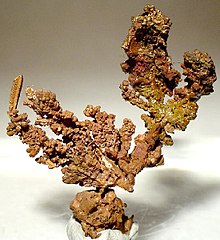Copperbelt
The Copperbelt (
Traditionally, the term Copperbelt includes the mining regions of Zambia's Copperbelt Province (notably the towns of Ndola, Kitwe, Chingola, Luanshya, and Mufulira in particular) and the Congo's Haut-Katanga and Lualaba provinces (notably Lubumbashi, Kolwezi, and Likasi). It arises because of the Katanga Supergroup, a Neoproterozoic sequence of geological formations.
In some contexts the term Copperbelt may exclude the Congo entirely. Zambia's Copperbelt became a province soon after independence in 1964, when it was named "Western province". President Kenneth Kaunda changed the name to its present-day "Copperbelt province" in 1969. From the time of the Bantu expansion, both the Congo's Katanga and Zambia's Copperbelt regions have been called "Ilamba" or "Lambaland", after the Lamba people. Both provinces are rich in mineral wealth.
Prehistory
The Copperbelt was not inhabited before the arrival of the Lamba people from the Luba and Lunda kingdoms.[dubious ] The Lamba settled at Lake Kashiba, and from there the Lamba kingdom spread eastward, northward, southward and westward.
History



The Western discovery of copper in Zambia is partly due to American scout Frederick Russell Burnham. In 1895 he led the Northern Territories (BSA) Exploration Co. expedition, which determined that major copper deposits existed in Central Africa.[1] Along the Kafue River in then-Northern Rhodesia, Burnham saw many similarities to copper deposits he had worked in the United States, and he encountered natives wearing copper bracelets.[2] In his report to the British South Africa Company Burnham said about the region:[3]
About 200 miles north of the
Katanga... The natives inhabiting this part of the country are skilled workmen, and have traded their handiwork with all comers, even as far afield as the Portuguese of the West Coast and the Arabs of the East. These natives, being miners and workers of copper and iron, and being permanently located in the ground, would give the very element needed in developing these fields.
The increasing use of copper bids fair to make it one of the most valuable products a country can have.... The copper mines of Montana and Arizona have proven of more value than the gold mines, regardless of the fact that the copper had to be hauled two thousand miles by rail to the seaboard, and the coal and coke to smelt it hauled hundreds of miles to the mines. So far as natural difficulties are concerned, this northern field can be fed from the coal deposits of the valley of the Zambezi [Burnham had previously discovered massive coal fields at Hwange], and the product shipped to the East Coast at a less expense than the product of Montana and Arizona can be laid on the dock at New York.
Many years later, the British South Africa Company built towns along the river and a railroad to transport the copper through Mozambique.[4]
During the 1950s, the Copperbelt was the largest copper-producing area in the world, including the
Katanga Supergroup

The Katanga Supergroup is a Neoproterozoic sequence of geological formations found in central Africa.[6] The formation is well-studied for its rich stratiform copper-cobalt deposits mined extensively in from the Central African Copperbelt in Zambia and the Democratic Republic of the Congo. Particularly rich outcrops of the Roan Group of the supergroup occur in eastern Katanga Province of the Democratic Republic of the Congo where open-pit copper mining has occurred.
The Katanga Supergroup nonconformably overlies the 883 Ma Nchanga Granite.[6] The Katangan Supergroup is divided into four metasedimentary series, from the oldest siliclastic and dolomitic Roan Group conglomerates, sandstones, and shales, to Nguba Group of mostly carbonates and carbon-rich shales, to the youngest, upper most Kundelungu Group including glacial metasediments and a cap carbonate.[6][7]
The Katanga Supergroup correlates with rocks of the Makuti Group in other parts of the Democratic Republic of Congo.[8]
Mines of the Katanga Supergroup
- Democratic Republic of Congo
- Dikulushi Mine
- Dikuluwe Mine
- Etoile Mine
- Frontier Mine, Katanga
- Kalukundi Mine
- Kalumines
- Kambove mines
- Kamfundwa Mine
- Kamoto Mine
- Kananga Mine
- Kinsenda Mine
- Kinsevere
- Kipoi Mine
- Kipushi Mine
- Kolwezi Mine
- Lonshi Mine
- Luishia Mine
- Luiswishi Mine
- Luita
- Mashamba East
- Mukondo Mine
- Musonoi Mine
- Musoshi Mine
- Mutanda Mine
- Mutoshi Mine
- Ruashi Mine
- Sase prospect
- Shituru
- Tilwezembe
- Zambia
See also
- Copperbelt Province
- Anvil Mining
- Domeyko Fault
- Glencore
- Camrose Resources Limited
- Union Minière du Haut Katanga(UMHK)
- Xstrata
- Sir Robert Williams, 1st Baronet, of Park
References
- ^ Baxter, T.W.; E.E. Burke (1970). Guide to the Historical Manuscripts in the National Archives of Rhodesia. p. 67.
- OCLC 407686.
- ^ Burnham, Frederick Russell (1899). "Northern Rhodesia". In Wills, Walter H. (ed.). . Simpkin, Marshall, Hamilton, Kent & Co. pp. 177–180.
- ISBN 1-85109-441-5.
- ^ Heinrich, E. Wm. (1958). Mineralogy and Geology of Radioactive Raw Materials. New York: McGraw-Hill Book Company, Inc. p. 298.
- ^ .
- .
- ISBN 978-0-444-41862-3.[page needed]
